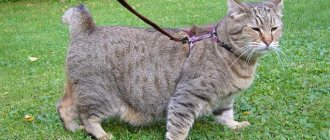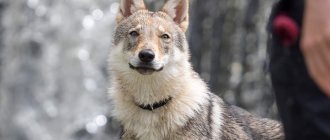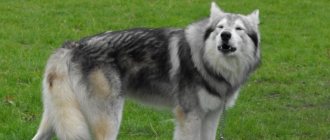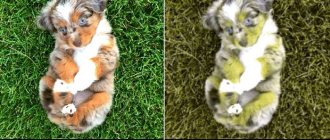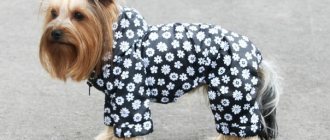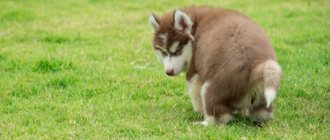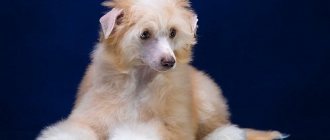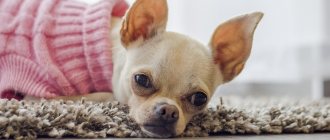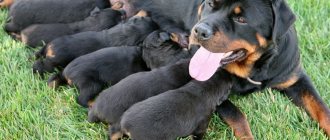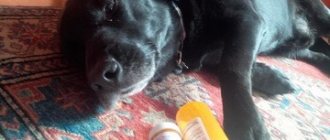Breed characteristics
| Short description | |
| Origin: | Russia |
| Conditions of detention: | Country house with large garden |
| Purpose: | Service |
| Color: | Zonar (wolf-like), light gray to dark, brown and black, rarely white |
| Wool length: | Average |
| Adult dog size: | Male – 60 cm with a weight of 50 kg; Female – 55 cm with a weight of 40 kg |
| Average life expectancy: | 18-20 years old (there were cases up to 30 years old) |
| Walk: | Needed three times a day |
| Physical activity needs: | High need |
| Fédération Cynologique Internationale (FIC) classification: | Not recognized by the IFF |
| Puppy price: | 20000-30000 rubles |
What to feed the dog
As written above, the wolf dog is not demanding in terms of maintenance and does not need special care. Such a strong animal is also not picky when it comes to nutrition. For normal development, he does not need to purchase premium dog food that is popular today.
The dog needs natural nutrition, and even the highest quality and most expensive food can be harmful to the pet’s health. Prepare porridge for the wolf dog, which can be cooked in meat broth. The animal is allowed to be given liver, meat, dairy products, kidneys, vegetables and fish several times a week.
The content of protein foods in the menu should significantly exceed the level of foods filled with carbohydrates. With such nutrition, the animal will grow healthy, hardy and strong.
It is imperative to follow a daily diet. The dog should be fed no more than 2 times a day. If you feed your animal more often, this will lead to obesity, which negatively affects his health.
History of the origin of the species
The wolf has better hunting qualities than the dog. His sense of smell and hearing are more developed. Many hunters have tried to cross domestic dogs with wolves to obtain these two characteristics. The first evidence of such attempts appeared about 10,000 years ago. It was at this time that wolves were domesticated.
However, such crossings were random, and the result was dogs with a bad character. They did not listen to their owners and were quite aggressive.
There is an assumption that in ancient times wolves themselves got used to people. They were friendly and not afraid of humans. It was then that the crossing of wolves and domestic dogs began.
There were a lot of attempts to breed such an exotic breed, and they were made in many countries . However, the first successful hybrid was bred in Russia at the Perm Institute of Internal Troops 15 years ago. It was obtained by crossing a female wolf and a male German shepherd. Now Volkosobov are bred for official purposes.
Later, a similar breed was developed in the Czech Republic with the name Volchak . In principle, this is a type of wolf-dog. They differ in appearance: the wolfdog is more like a wolf, the wolfdog is more like a shepherd dog. And this is not the only type of hybrids. Crossing can be with another dog, and the result will be different accordingly.
Now Wolfdogs are just beginning to gain popularity, so they are not yet recognized by the International Canine Federation. They are not yet allowed to perform official duties in the army or police.
History of the wolfdog breed
Wolfdog breeds only became popular in the 2000s, but in fact such animals have been around for a long time. Scientists believe that accidental interbreeding between domestic dogs and wild wolves occurred at least 10,000 years ago. During this time, people periodically tried to tame hybrids, but most often this failed due to the aggressive nature of the latter. Wolfdogs were as strong as wolves, but they were less afraid of humans.
For the first time, the most large-scale work on breeding hybrids was carried out in the 14th century in Germany. During the experiment, 200 wolfdogs were born there, but the animals did not lend themselves to training and socialization, so the research had to be stopped.
The teeth of a hybrid are much more powerful and stronger than those of a dog, since the breed was originally created for killing.
The most successful attempts to breed wolf-dogs took place in the Czech Republic and Russia. The Czech wolfdog was bred scientifically: the best male sire among German shepherds was selected and mated with a tame wolf. At first, non-viable puppies were born, but after replacing the male, the first wolf cubs were born. Half-breeds helped in guarding borders and were trainable. Permission was even issued for their transportation.
The main difficulties in breeding wolf-dogs are due to the fact that a wild wolf feels uncomfortable among people and also does not allow dogs to approach it.
In Russia, a couple was created not artificially, but out of love. The tame she-wolf herself chose a German shepherd as her “groom.” The first litter was received in 2003. The puppies looked more like their mother. They successfully completed socialization and were registered as Russian wolf-dogs.
The future creator of the wolf-dog breed literally saved Naida: he bought her from the previous owner, who wanted to make a stuffed animal out of her
Ordinary dog lovers, as a rule, do not get wolf-dogs, since these companions are more dangerous than ordinary dogs. For example, in 2007, several Wolfhounds terrorizing a village attacked a two-year-old child and killed him. The breeder from whom the owner bought the wolfdogs tried to testify in their favor. One of the arguments was that only one child could not die during the Wolfhound attack. If not properly socialized, hybrids pose a great danger, and it is very difficult to socialize wolf-dogs.
Distinctive features
The wolfdog differs from both the dog and the wolf . Representatives of this breed are very similar in appearance to a wolf, but in their obedience and devotion to humans they are similar to domestic dogs. Wolfdogs are smaller in size than a wolf, but larger than a dog. This breed combines all the traits of its parents equally:
- Size and weight: male – 60 cm and 50 kg; female – 55 cm and 40 kg.
- Head: elongated, proportional to the body.
- Eyes: almond-shaped, amber or light brown in color.
- Ears: triangular, protruding, medium size.
- Nose: developed, wide nostrils, color only black.
- Neck: dry, at an angle of 40˚.
- Paws: The front legs are straight and narrowly set, the paws are turned out, high, muscular.
- Torso: fit, muscular.
- Tail: set high, reaching to the metatarsus, thick.
- Coat: thick, with undercoat.
- Color: wolf (from light gray to dark, brown and black).
Unrecognized breeds
There are also young breeds of dogs similar to wolves that are not recognized by the FCI. The breeders sought to create the appearance of a gray wolf, but with an easy-going and manageable character.
Tamaskan dog
Height: 60-70 cm
Weight: 23-45 kg
Not recognized by the IFF
This breed comes from Finland. Siberian Huskies, Alaskan Malamutes, and German Shepherds took part in the crossing.
The result is a family dog that gets along well with children. Tamaskans, like their ancestors, have good working qualities and endurance. They need constant physical activity and long walks. They are not demanding in terms of care.
Northern Inuit
Height: 59-76 cm
Weight: 25-50 kg
Not recognized by the IFF
Another unrecognized breed that originated in Canada and developed in Great Britain. The purpose of breeding is to make the domestic dog look like a wolf. The crossbreeding involved Siberian Huskies and German Shepherds. The result: a large dog that looks like a white wolf. The Inuit is a balanced and calm dog with excellent working qualities.
Inuit are often cast as wolves in films. They can be seen in the popular series “Game of Thrones”.
Utonogan
Height: 61-73 cm
Weight: 25-50 kg
Not recognized by the IFF
It was developed in the UK. The word "Utonogan" means "wolf spirit". Utonogan is a cross between a Siberian Husky, an Alaskan Malamute and a German Shepherd. Representatives of the breed are very similar to wolves, but they look fluffier.
Utonogans cope with the role of a family companion dog and are suitable for guarding a country house. They were created to live in harsh outdoor conditions, so they have a thick undercoat.
It is also worth noting that ducklings are famous for their voracious appetite; you will have to carefully monitor your pet’s diet to prevent obesity.
Wolfdogs
Wolf dogs are a cross between a dog (canis lupus familiaris) and a wolf (canis lupus). Wolfops are not recognized by any canine organization in the world.
The hybrid was developed at the Perm Institute of Internal Troops. Scientific director of the project, Professor V.M. Kasimov. Individuals of wolves and German shepherds were used in the crossing.
Wolfdogs are used to guard the Mongolian and Chinese borders of Russia . Border guards working with wolf-dogs note their advantages over other service breeds: more developed sense of smell, quick reaction, high intelligence and the size of the wolf.
Wolfops are also distinguished by good health and unpretentiousness. However, we can say with certainty that this is not a family pet . Wolf dogs require professional education and training. They are definitely not suitable for an inexperienced owner as a first dog. This is an option for intelligence officers.
In other parts of the world, attempts are also being made to breed wolf-dogs. For example, there is mention of a certain breeder from Texas trying to create a hybrid of a dog and a wolf with stable external characteristics.
The owner of a nimble dog named Buk.
Wolf dogs are mysterious creatures that are born as a result of crossing a wolf and a dog. A cross between animals of these two species leads to the birth of a hybrid, which not only looks like a wolf. Even in the 3-4th generation, he can be wary of humans. However, this does not stop wolf dogs from becoming increasingly popular these days.
Photo of an adult dog
Photos of puppies
Features of character and behavior
Initially, Volkosobs were bred specifically for official purposes. Now they can be found as pets.
- The character of representatives of this breed directly depends on the content of wolf genes in their DNA . Even fourth-generation dogs can be too aggressive and distrustful of people. Therefore, Wolfdog should be trained only by professional dog handlers.
- Wolf dogs are distinguished by their extreme intelligence . Because of the German Shepherd's genes, they learn commands quickly and are not difficult to train.
- Unlike their domestic parents, Wolfdogs, thanks to their sense of smell, complete search tasks 10 times faster. It takes a shepherd 6 minutes, a wolf-dog less than a minute. The jaws of this unusual breed are many times stronger. If he grabs your hand, it is almost impossible to unhook him. It will only be released on the owner's command.
- Wolves are social animals. They constantly need a pack and a leader. So are Wolfdogs . They always need a leader, and if the owner cannot show that he is in charge, the pet can begin to dominate. This will result in a complete loss of control over the dog. It is precisely because of the love for the pack, transmitted from the wolf, that Wolfdogs like to live in large families.
- Wolf dogs are quite friendly . They can easily make friends with anyone. This is good when an adult dog is adopted. But you should not teach them to have good relationships with strangers, because this breed is intended for protection.
Advantages
The wolf-dog has many advantages:
- Developed intelligence;
- Excellent memory. remember commands well;
- Excellent security qualities;
- Judge hereditary diseases;
- It will not just howl or bark, it is quiet;
- Playfulness;
- Sociability;
- Acute sense of smell and hearing;
- Longevity. Life expectancy (up to 20-30 years);
- Easy adaptation to changing living conditions;
- Easy grooming;
- Friendliness;
- Good cold tolerance.
Flaws
Despite the large number of advantages, Wolfdog also has disadvantages:
- Cannot live in an apartment (need more space);
- High need for physical activity and training;
- They shed heavily;
- Not always gentle;
- Not always friendly to other animals.
Dogs that look like wolves
Tamaskan dog
The Tamaskan dog, like other wolf-dogs, is very similar to a wolf . But, like the northern Inuit dog, it does not have “wolf blood” in its breed. The experiment was carried out in Finland with the goal of creating a family-friendly, friendly dog that looks like a wolf.
As a result of numerous crossings of various types of wolf-dogs, including the Northern Inuit, Alaskan Malamute, Siberian Husky, the attempt was crowned with success. The result was a wonderful pet with good working qualities.
The breed is not recognized by the FCI.
The Tamaskan dog is large, male height up to 71 cm, weight up to 45 kg.
- Representatives of the breed are patient, good-natured, and do not show aggression.
- They are very sociable and ready to cooperate, easy to learn.
- They get along well with children and other animals.
- Not recommended for keeping in an apartment.
- Also, residents of southern cities with mild climates should not get this dog.
- The pet will feel best when it has the opportunity to “work” in a harness in an open space.
- The ideal option is to keep two or more Tamaskan dogs in a large yard and free-range.
- Animals prefer to be in a pack.
The price of a baby Tamaskan dog in European kennels starts from 1200 US dollars.
Utonagan
An experiment similar to the Finnish one is being conducted in the United Kingdom. In the vastness of this country, cynologists crossbreed individuals of the Alaskan Malamute, Siberian Husky and German Shepherd. Selection work continues at the present time, but the main task was completed at the end of the 20th century.
The experiment was considered successful, since as a result, a surprisingly friendly animal was born, outwardly similar to a wolf, but with thicker, fluffy fur. And in 1996, a significant event occurred - a club of passionate lovers of this breed was established in England. Since then, animals have become widespread in the UK, Scotland, and later in Canada and the USA.
Utonagan is a tall and large dog, height reaches 73 cm, weight 50 kg. Males are traditionally larger than females.
- Pets have a calm, balanced character and are considered an ideal family companion.
- Utonagans are friendly, affectionate dogs that strive to communicate.
- They perfectly sense the mood of the owner and surprisingly easily adapt to his character and lifestyle.
- They are ideal for active people, as they are energetic, active, and love to have fun and play.
There are no nurseries in Russia, so you will have to go to the UK to get a puppy, where the cost starts from 800 US dollars.
Northern Inuit
The Northern Inuit is a dog resulting from crossing an Alaskan Malamute, a Siberian Husky and a German Shepherd . In other words, the northern Inuit dog does not have the genes of a pure wolf; mestizos of the named breeds were used to create it.
Initially, breeding work was carried out in Canada in the mid-80s, and the northern Inuit entered the territory of the Kingdom of England later. The purpose of the experiment was to instill “wild, wolf” qualities in a domestic animal.
The breed is not recognized by the FCI.
The size of the animal is impressive - males are found up to 81 cm in height and weighing up to 50 kg.
An interesting fact is that northern Inuit dogs are so similar to wolves that they are often used in cinema. For example, they can be seen in Game of Thrones.
Dogs are balanced and calm. They have a soft, obedient character.
It is very difficult to find Northern Inuit puppies in Russia; the price of a baby, including transportation from Europe or Canada, can reach 6,500 US dollars.
Care and maintenance
Wolf dogs do not tolerate small spaces and chains. It is better to have them for people who have a country house with a large garden . For your pet, you need to make a spacious enclosure with a high fence and place a warm booth there. Although Wolfdogs tolerate cold and heat well, it is necessary to avoid drafts and make sure that there is plenty of shade in the yard.
There are no particular difficulties in caring for the Wolf Dog. The main thing is to feed on time, provide enough water, monitor the condition of the eyes and ears, look at the color of the mucous secretions and comb out the fur during shedding.
Nutrition
Wolfdogs should not be fed dry food, as their stomach cannot digest it . They can be given cereals, meat and even vegetables. They love to chew on the marrow bone and will not refuse sweets. But you shouldn’t abuse the latter, if only as a reward. Also, do not forget about the wolf nature of Wolfdog. They need to be given raw meat or sea fish every day.
It is better to feed puppies in small portions about 6 times a day. And then, as the dog grows older, you can switch the dog to a three-course diet. The portion also increases.
It is necessary to exclude from the diet:
- legumes,
- millet (as well as everything that is made from it),
- grape,
- acorns,
- nuts,
- pistachios and raisins.
We recommend that you read a detailed article on the topic: “How and what to feed a dog: types and characteristics of nutrition.”
Health
Wolf dogs are distinguished by excellent health. They are not predisposed to diseases of purebred dogs.
- Wolf dogs easily adapt to environmental changes. They tolerate cold and heat well. But you still need to exclude drafts and ensure the presence of shade in the enclosure.
- The life expectancy of representatives of this breed reaches 20 years. However, there have been cases where Wolfdogs lived up to 30 years. And even into old age, dogs retain excellent hearing, sense of smell and mobility.
Vaccinations
- The need to visit a veterinarian is much less, unlike purebred dogs . Wolf dogs do not suffer from the diseases of their fellow animals. The only disease you should truly be afraid of is rabies.
- Due to the characteristics of wolf DNA, there is some intolerance to vaccinations by Wolfdogs . Therefore, even to a rabies vaccine there can be a strange reaction.
Dog handlers advise, just in case, to give your dog the same vaccinations as pets after consultation with a veterinarian.
Important article on the topic: “Everything you need to know about dog vaccinations.”
Diseases
As noted earlier, Wolfdogs do not suffer from the diseases of their domestic counterparts. Infectious diseases have consequences for them. Rabies is fatal to them.
Walk
- Wolfdog is a very active breed.
- They need long walks with strenuous exercise.
- It is better to walk in specialized parks and in the forest.
- This must be done at least 3 times a day, plus during the day the dog will run around the enclosure.
Grooming
Caring for a wolfdog's fur is not so difficult:
- It only needs to be brushed during the shedding season.
- You can wash your Wolfdog once a month.
- In summer, the number of baths should be increased so that the dog can tolerate the heat more easily.
- In winter it is better not to bathe so often.
- The dog is usually not allowed into the house, which means that it will spend most of its time outside.
- Due to wet fur, which is quite difficult to dry completely, the dog can catch a severe cold.
Wolf dogs: what are they?
As a rule, wolf-dogs are black and gray in color. Occasionally it is continuous, but most often with transitions. The color of the coat largely depends on the color of the parents. On average, the weight reaches 30–38 kg. For comparison: a wolf's body weight can be up to 100 kg. Unlike dogs, many wolf-dogs cannot bark, but they howl. The life expectancy of such pets is record-breaking: it reaches 20–30 years. Usually such large dogs rarely live even to 15 years.
At the moment, long-haired breeds of wolf-dogs are unknown, but in Germany an experiment was conducted on crossing a wolf with a poodle. It ended unsuccessfully.
It is impossible to predict the character of a wolf-dog in advance, since it depends on the generation, on the behavior of the parents, and on how many genes are passed on from the wolf. However, it is possible to identify features common to all representatives. Wolf dogs are very smart. Their intelligence is higher than that of dogs. They are independent and know how to make decisions quickly. For this we should thank the wolf genes. Most wolfdogs learn quickly if the trainer manages to establish contact. Representatives of the breed are active and require regular exercise. They are difficult to socialize; even experienced owners cannot always cope without a dog handler.
A wolfdog named Yuki, rescued from euthanasia, is a contender for the title of the largest wolfdog in the world: the dog weighs 54 kg
Wolf dogs were bred for service work, so they do not become attached to one person. They are not as emotional and sentimental as dogs, but they can give their lives to protect their owner. If adapted correctly, wolf-dogs treat strangers with suspicion; if adapted incorrectly, they can become aggressive. Such a dog cannot be left alone with children. Wolf dogs can attack other domestic animals.
Mating
Service Wolfdogs are usually not bred with each other, because the number of wolf genes decreases. And this leads to the fact that such qualities as, for example, sense of smell, gradually become worse, and such dogs are no longer suitable for service.
- At home, pets can be bred, just like ordinary dogs . But this can be quite difficult, because Wolfdogs are just starting to gain popularity, and finding a partner is not so easy.
- It is better to breed after the third heat . That is, approximately eighteen months.
- First you need to prepare properly . To do this, it is necessary to provide the dogs with enough water. The floor in the room is covered with carpet. This is done to prevent the animals' paws from slipping. Just in case, dogs are muzzled.
- Help may be needed at the initial stage of mating , when the male leans his body onto the female. Further, when it comes to the “castle”, it is better not to disturb the pets.
Read a detailed article on the topic: “Everything you need to know about breeding dogs: appropriate age, what to do if it doesn’t work out, rules and tips.”
How to raise and care for an animal
Before you go to a wolf-dog nursery to choose a puppy, you need to think about why you need it and whether you can handle raising it? The fact is that wolf dogs are smart and incredibly complex animals. Only experienced people can care for and raise them more successfully.
Dogs are not meant to live in an apartment, as they need space. In a small and enclosed room, dogs will behave aggressively and inappropriately. Even small wolf and dog puppies can “destroy” an apartment in literally half an hour during the owner’s absence. In addition, they do not bark, and love to give long “night concerts.” This causes great concern to the neighbors.
Therefore, it is worth keeping the animal in a country house. It is preferable to place a warm booth on the site and build a spacious enclosure. It is imperative to ensure that the animal cannot leave the suburban area. After all, a wolf dog can independently escape in order to go into the forest forever or join a pack of stray dogs.
Usually the wolf-dog is not allowed into the house. Only in severe frosts can they be allowed to spend the night in their home. The biggest advantage of the animal is that it requires minimal care. The dog will stand near the door to the house and normally endure difficult weather conditions without showing concern.
Key points in training
- Training a Wolf Dog is not difficult. They are very intelligent and quickly remember all commands, and if it was initially shown that the owner is in charge, then the dog will be the most loyal and very obedient.
- As soon as the puppy gets into the house, it is necessary to immediately show who the leader is. This breed has a terrible habit of dominating its owner. This behavior must be stopped immediately so as not to lose control over the dog.
- Read about how to properly train a dog in the article: “Training a puppy: effective methods from dog handlers, learning commands at home.”
It is better to give the puppy for training to a professional dog handler. He will use a special method to motivate the dog to follow commands.
How to choose a puppy
Choosing a puppy is the most difficult thing. There is an opinion that there are no official nurseries where you can buy wolf-dogs.
However, there are two nurseries: in Perm and the Moscow region. There are not many puppies, so there is a waiting list to buy them. That is, the puppy must be ordered in advance.
Breeders are not always willing to give away puppies due to the complex nature of this breed. And not every dog handler will undertake to train such a dog. Wolfdogs are bred only for service purposes in the army.
To choose a good puppy, you need to follow the same rules as for other dogs. First of all, look at the dog himself. The puppy must be:
- Active and playful;
- They are not afraid of man;
- Outwardly healthy and clean.
Next, you need to ask the breeder the following questions:
- Are there any health problems, if so what?
- What vaccinations have been given and which ones still need to be done;
- Have you been treated for fleas and worms?
- How friendly is the puppy's mother;
It is better to ask the breeder how to properly care for it, how to train it (perhaps he will recommend a trusted dog handler) and many other questions. This way you can accurately determine whether such a breed is suitable for a family.
Wolfdog is a rather difficult breed to train. She was created by crossing a female wolf and a male German Shepherd. They have an unsurpassed sense of smell, hearing and excellent health. This breed has many advantages. However, you must initially build the right relationship with the Wolf Dog, otherwise you may lose control over your pet forever.
Successful breeding of wolfdogs in Russia
At the end of the 90s, breeding of hybrids of wolves and German shepherds began in Perm. Vyacheslav Kasimov, a professor at the Perm Institute of the Ministry of Internal Affairs, who was engaged in selection work, settled on a combination of wolf and dog blood of 12.5 and 87.5 percent (abroad these figures reached 30 and 70, respectively). This made it possible to create an ideal in terms of the combination of working and physical qualities. Cowardice and aggressiveness disappeared, the ability to train was the same as that of dogs. Resistance to diseases has increased so much that vaccination is no longer necessary. Life expectancy has increased to 20–25 years. Applications were found in the border service, National Guard troops, police, and other special services.
Russian Wolfdog
The use of dogs with wolf blood increases the possibilities compared to the use of representatives of other breeds. So, a clear indicator is working with a trace that is up to 3 days old. However, this will require their owner to demonstrate leadership qualities and good skills in training four-legged pets. If successful, the person will receive a devoted assistant whose abilities go beyond the usual idea of service dogs.
Photos from wolfdog owners
[webnavoz_instagram json=”{'link':'https:\/\/www.instagram.com\/p\/ByNSpylJPlW\/','author':'malakhovskiivolkodav','link_img':'https:\/\ /instagram.fhen1-1.fna.fbcdn.net\/vp\/34e307234fc6de5592f7743687baeec2\/5D991F54\/t51.2885-15\/e35\/s1080x1080\/61553513_2095366937257569_ 8798439988110498954_n.jpg?_nc_ht=instagram.fhen1-1.fna. fbcdn.net'},{'link':'https:\/\/www.instagram.com\/p\/ByNXqxkg5vV\/','author':'viialisitsyna','link_img':'https:\/ \/instagram.fhen1-1.fna.fbcdn.net\/vp\/c64eb0bda538ab797bfc29e93467c71a\/5D9D4120\/t51.2885-15\/e35\/61645746_449703475596124_44030312784 80353867_n.jpg?_nc_ht=instagram.fhen1-1.fna.fbcdn. net'},{'link':'https:\/\/www.instagram.com\/p\/ByNw29PoufC\/','author':'ivlmary','link_img':'https:\/\/ instagram.fhen1-1.fna.fbcdn.net\/vp\/66563c16cda952616483bed2473c9ae5\/5D999A75\/t51.2885-15\/e35\/60769851_393113554747105_621687923509677 3208_n.jpg?_nc_ht=instagram.fhen1-1.fna.fbcdn.net' },{'link':'https:\/\/www.instagram.com\/p\/ByLqOIvg2t2\/','author':'shanti.wolfdog','link_img':'https:\/\/ instagram.fhen1-1.fna.fbcdn.net\/vp\/3495bcd419bdb28c51aafe8fc0ba3a19\/5D914554\/t51.2885-15\/e35\/p1080x1080\/60653316_353561422018088_6 01485195041154647_n.jpg?_nc_ht=instagram.fhen1-1.fna.fbcdn .net'},{'link':'https:\/\/www.instagram.com\/p\/ByGlgH0AtfR\/','author':'shanti.wolfdog','link_img':'https:\ /\/instagram.fhen1-1.fna.fbcdn.net\/vp\/e17bbc9f38d09389e0ad6d8527629146\/5D989804\/t51.2885-15\/e35\/p1080x1080\/61043930_30979518327699 2_4591074722820371219_n.jpg?_nc_ht=instagram.fhen1-1. fna.fbcdn.net'},{'link':'https:\/\/www.instagram.com\/p\/ByBObEOgD_U\/','author':'shanti.wolfdog','link_img':' https:\/\/instagram.fhen1-1.fna.fbcdn.net\/vp\/bd87997ba0c71b95d31a36316e38f63b\/5D8E862F\/t51.2885-15\/e35\/p1080x1080\/60823118_1487391262 61719_3369631420551336374_n.jpg?_nc_ht=instagram.fhen1 -1.fna.fbcdn.net'},{'link':'https:\/\/www.instagram.com\/p\/Bx2C2NUHq9A\/','author':'lexxyblack','link_img': 'https:\/\/instagram.fhen1-1.fna.fbcdn.net\/vp\/afc844d0e9568a34205ed2a631c99b0b\/5D98FEC4\/t51.2885-15\/e35\/s1080x1080\/61460679_2360059310 986163_8189527149555788615_n.jpg?_nc_ht=instagram. fhen1-1.fna.fbcdn.net'},{'link':'https:\/\/www.instagram.com\/p\/BxsvmGQDvHT\/','author':'moonlight_fantazy','link_img' :'https:\/\/instagram.fhen1-1.fna.fbcdn.net\/vp\/57a8b3aa719677f766ae314382731787\/5D84E7EB\/t51.2885-15\/e35\/60391935_138082700668862_335 327289762236418_n.jpg?_nc_ht=instagram.fhen1- 1.fna.fbcdn.net'}”]
